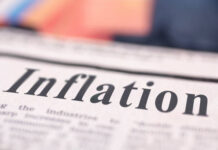The Swiss National Bank (SNB) and the Bank of England (BoE) surprised by maintaining their rates unchanged at yesterday’s trading session. The Bank of Japan (BoJ) surprised by maintaining its ultra-lose monetary policy stance unchanged. Combined with a hawkish pause earlier this week, the major currencies further sank against the greenback. The USDCHF advanced past the 200-DMA, and Cable slipped to 1.2232, a fresh low since March, and whispers of a potential return to parity against the US dollar sparked, yet again. Reasonably, the pound-dollar could return to 1.20, and below, if the major 38.2% Fibonacci support – which stands at 1.2080 is pulled out and lets the pair slip into a medium-term bearish consolidation zone. But we will likely see the Federal Reserve (Fed) soften its tone before we start talking about parity in Cable.
Now, looking at what the BoE did, you know that I was surprised, and intrigued with the decision. In Switzerland for example, inflation – official inflation – steadied below the SNB’s 2%, target. The latest data shows that the Swiss CPI is at no higher than 1.6% – even though we are expecting a monstrous rise in health insurance costs, and another 20% rise in average in electricity costs that will certainly drill holes in our pockets at the start of next year, but for now inflation is at 1.6%, say the numbers, and alone, it justifies a SNB pause. But in Britain, the no action is quite premature. Inflation in Britain is almost at 7%, the energy prices are rising, the war in Ukraine is nowhere close to being over, sterling pound is now losing value, which means that whatever the Brits will import from now will cost them more than during the last months, when the pound was appreciating. It’s hard to see how, with all these developments, the BoE won’t be obliged to hike, again. The only way is a really bad economic performance.
A bright spot
If there is one bright spot in Britain with all this, it is the FTSE100. First, the rising energy prices are good for the energy-rich FTSE100. Second, softer sterling makes these companies more affordable for international investors, who should of course think of hedging their sterling exposure, and third, more than 80% of the FTSE100 companies’ revenues come from oversees, which means that when they convert their shiny dollar revenues back to a morose sterling, well, they can’t really complain with a stronger dollar. Consequently, if a more dovish BoE is bad for sterling, the combination of a hawkish Fed and a dovish BoE and a pitiless OPEC is certainly good for the FTSE100. The index has been left behind the S&P500 this year, as the tech rally is what propelled the American index to the skies, but that technology wind is now turning direction. The FTSE 100 broke its February to September downtrending trend to the upside and is fundamentally and technically poised to gain further positive traction, whereas, the S&P500 is heaving a rough month, with technology stocks set for their worse performance this year, under the pressure of rising US yields, which make their valuations look even more expensive.
Interestingly, the US 2-year yield peaked at 5.20% after the Fed’s hawkish pause this week and is back headed toward the 5% mark, but the gap between the US 2-year yield and the top range of the Fed funds rate is around 40bp, which is a big gap, and even if the Fed decided not to hike rates, this gap should narrow, in theory. If it does not, it means that bond traders are betting against the Fed’s hawkishness and think that the melting savings, the loosening jobs market, tightening bank lending conditions and strikes, and restart of student loan repayments and a potential government shutdown could prevent that last rate hike to happen before this year ends. And indeed, activity on Fed funds futures gives more than 70% chance for a third pause at the FOMC’s November meeting, and Goldman Sachs now sees the US expansion slow to 1.3% from 3.1% printed in the Q3. KPMG also warned that a prolonged auto stoppage may precipitate contraction. And if no deal is inked by noon today, the strikes will get worse.
One’s bad fortune is another’s good fortune
The Japanese auto exports surged big this year, they were 50% higher in yen terms. The yen is certrainly not doing well, but yes, you can’t have it all. That cheap yen is one of the reasons why the Japanese export so well outside their country. And in case you missed, the BoJ did nothing today to exit their hyper-ultra-loose monetary policy. They didn’t even give a hint of normalization, meaning that the yen will hardly strengthen from the actual levels. In the meantime, Toyota, Mitsubishi and Honda shares are having a stellar year, and the US strikes will only help them do better.














